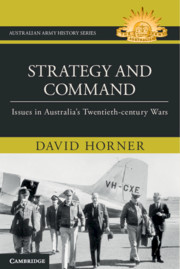Book contents
- Strategy and Command
- Other titles in the Australian Army History Series
- Acknowledgement of Country
- Strategy and Command
- Copyright page
- Contents
- Figures, maps and tables
- Preface
- Acknowledgements
- Abbreviations
- Introduction
- Chapter 1 The influence of the Boer War on Australia’s First World War commanders
- Chapter 2 Preparing for war, 1901–14
- Chapter 3 The AIF’s commanders
- Chapter 4 Strategic planning between the wars
- Chapter 5 Identifying the threat from Japan in 1941
- Chapter 6 A pivotal year in Australian history: 1942
- Chapter 7 Australia and coalition warfare in the Second World War
- Chapter 8 Deciding Australia’s war strategy in 1943
- Chapter 9 Advancing national interests
- Chapter 10 Higher command in the Korean War
- Chapter 11 Higher direction of the army in the Vietnam War
- Chapter 12 The Gulf War, 1991
- Chapter 13 Deploying and sustaining INTERFET in East Timor in 1999
- Chapter 14 Developing a command structure for joint operations
- Notes
- Bibliography
- Index
Chapter 13 - Deploying and sustaining INTERFET in East Timor in 1999
Published online by Cambridge University Press: 08 October 2021
- Strategy and Command
- Other titles in the Australian Army History Series
- Acknowledgement of Country
- Strategy and Command
- Copyright page
- Contents
- Figures, maps and tables
- Preface
- Acknowledgements
- Abbreviations
- Introduction
- Chapter 1 The influence of the Boer War on Australia’s First World War commanders
- Chapter 2 Preparing for war, 1901–14
- Chapter 3 The AIF’s commanders
- Chapter 4 Strategic planning between the wars
- Chapter 5 Identifying the threat from Japan in 1941
- Chapter 6 A pivotal year in Australian history: 1942
- Chapter 7 Australia and coalition warfare in the Second World War
- Chapter 8 Deciding Australia’s war strategy in 1943
- Chapter 9 Advancing national interests
- Chapter 10 Higher command in the Korean War
- Chapter 11 Higher direction of the army in the Vietnam War
- Chapter 12 The Gulf War, 1991
- Chapter 13 Deploying and sustaining INTERFET in East Timor in 1999
- Chapter 14 Developing a command structure for joint operations
- Notes
- Bibliography
- Index
Summary
On 18 September 1999 an Australian naval task group consisting of the Australian frigates HMA Ships Adelaide and Anzac, the heavy landing ship HMAS Tobruk, the landing craft HMA Ships Balikpapan, Brunei and Labuan, the supply ship HMAS Success, the New Zealand frigate HMNZS Te Kaha and the British frigate HMS Glasgow sailed from Darwin harbour. At dawn on 20 September Anzac and Success joined the frigate Darwin, already stationed off the coast of East Timor, to patrol the waters off the capital, Dili, and secure the harbour. Then at 7 a.m. five RAAF C-130 Hercules transport aircraft landed at Dili’s Komoro airfield carrying Australian and New Zealand Special Air Service (SAS) troopers and the leading elements of Headquarters 3rd Brigade, who secured the airport and established contact with elements of the Indonesian Armed Forces (TNI) to ensure their cooperation. A British Gurkha company was also among the early group of soldiers. So the first troops of the multinational force known as the International Force East Timor, or INTERFET, arrived in East Timor.
Keywords
- Type
- Chapter
- Information
- Strategy and CommandIssues in Australia's Twentieth-century Wars, pp. 237 - 263Publisher: Cambridge University PressPrint publication year: 2021

